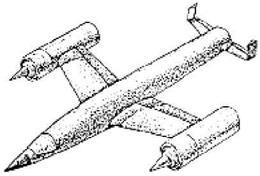INTERCONTINENTAL BOMBERS
Ever since the reorganization of NII-1 under the Ministry of the Aviation Industry in 1944, one of its main goals had been to incorporate rocket and ramjet technology into aviation. On 29 November 1946 the new head of NII-1 became Mstislav Keldysh. One of his first assignments was to study a German hypersonic winged transcontinental bombardment aircraft known as the Silbervogel (“Silver Bird”) or the “antipodal bomber”. This was the brainchild of Dr. Eugene Sanger and mathematician-cum-wife Irene Brendt, who proposed it in a document in August 1944, one copy of which was found by the Russians in Germany after the war. Launched horizontally by a rocket-powered sled, it would use its own rocket engines to boost itself to orbital altitude and subsequently ricochet off the Earth’s atmosphere, dropping a bomb over the desired target during one of the dips. Stalin was impressed enough by the Silbervogel to dispatch an Air Force officer named Grigoriy Tokaty-Tokayev to kidnap Sanger in France in 1948, but Tokaty-Tokayev took the opportunity to defect to the West instead [10].
Actually, by this time Keldysh had already come to the conclusion that the Silbervogel was an unrealistic design, among other things because of the high specific impulse required for the engines and the high propellant load. In 1947 he had come up with an alternative intercontinental bomber that would use a combination of supersonic ramjets (scramjets) and rocket engines to perform a mission very similar
|
Soviet antipodal bomber. |
to the Silbervogel. In what amounted to the first serious Soviet spaceplane proposal, Keldysh’s single-seater bomber would be horizontally rail-launched as the Sanger/ Bredt bomber, but then switch to two wing-mounted scramjets to reach an altitude of 20 km. Subsequently, the scramjets would be jettisoned, after which a 100-ton thrust rocket engine would kick in to send the vehicle to the upper reaches of the atmosphere, where it would fly several “dip-and-skip” trajectories to reach its final target. The scramjet and rocket engines would share several systems such as a common kerosene tank and also a common hydrogen peroxide tank to drive the turbopumps [11].











